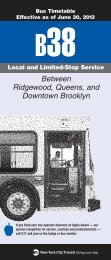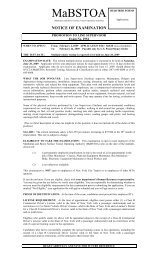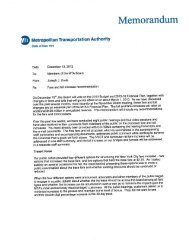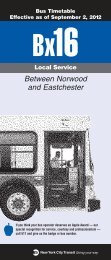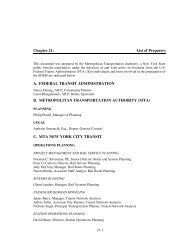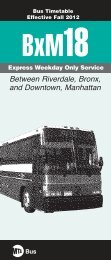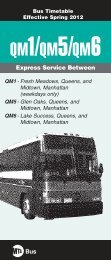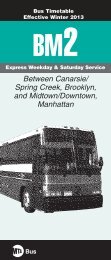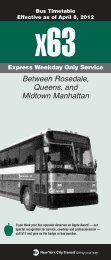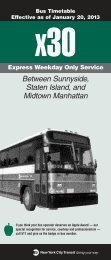Greening Mass Transit & Metro Regions: The Final Report - MTA
Greening Mass Transit & Metro Regions: The Final Report - MTA
Greening Mass Transit & Metro Regions: The Final Report - MTA
Create successful ePaper yourself
Turn your PDF publications into a flip-book with our unique Google optimized e-Paper software.
New York City. 6 By improving traffic flow, transit optimizes<br />
regional mobility for both passenger and freight sectors.<br />
This in turn reduces fuel costs, vehicle operating costs,<br />
and the costs associated with traffic accidents. By easing<br />
congestion, transit also reduces CO2 emissions from the<br />
remaining auto traffic, resulting in yet another level of<br />
carbon avoidance. Moreover, studies show that in periods<br />
of rapid land development and population growth, transit<br />
rail systems in highway corridors will absorb and stabilize<br />
any related rise in traffic congestion.<br />
3. Optimizing Land Use: <strong>Transit</strong> enables more clustered<br />
residential and commercial development, which brings<br />
dramatic economic and sustainability gains. According to<br />
a study by the National Research Council, more compact<br />
settlement patterns could save the nation $540 billion in<br />
building and infrastructure costs. 7 Moreover, compact<br />
transit-based development not only reduces automobile<br />
travel, it reduces the average miles between destinations<br />
for all modes of travel, including automobiles. Thus, the<br />
land-use patterns generated by transit produce a “virtuous<br />
spiral” with an ongoing decline in energy consumption and<br />
corresponding rise in carbon avoidance. This is clearly<br />
evident in high-density, transit-rich New York City, where<br />
per capita energy consumption is now about one quarter<br />
the national average.<br />
4. Generating Higher Values: <strong>The</strong> value of transit to<br />
regional economies will be felt through higher worker<br />
mobility, lower energy costs, reduced pressure on public<br />
services, and other effects. Significantly, those benefits<br />
will also extend beyond direct transit system users to the<br />
economy at large. One example is the impact on property<br />
values, as demonstrated in numerous studies. A study for<br />
the Federal <strong>Transit</strong> Administration, for example, indicates<br />
an increase in residential equity value of about $160 for<br />
every 100 additional feet of transit station proximity. 8<br />
Another study in Washington, D.C. shows that for each<br />
1,000 foot decrease in the distance to a transit rail station,<br />
commercial property values increased by $2.30 per square<br />
foot, while the total value for properties averaging 30,500<br />
square feet rose by over $70,000.<br />
<strong>The</strong>se examples indicate some of the ways in which the<br />
Blue Ribbon Commission’s recommended enhancements<br />
of the <strong>MTA</strong> system will achieve not only critical environmental<br />
goals but economic gains that will help to offset<br />
A <strong>Transit</strong>-Based Economy Produces More with Less Energy<br />
<strong>The</strong> <strong>MTA</strong> sells some 8.5 million passenger trips daily at twice the energy efficiency<br />
of the most advanced hybrid cars. Thanks largely to the <strong>MTA</strong>’s efficiency, New<br />
Yorkers are among the world’s most productive workers and thriftiest energy users<br />
– with a per capita BTU consumption of one quarter of the national average.<br />
recessionary effects across the region. <strong>The</strong> report will also<br />
begin the important process of quantifying carbon avoidance,<br />
implementing lifecycle accounting and other internal<br />
steps to prepare the <strong>MTA</strong> for an emerging low-carbon<br />
economy. <strong>The</strong>se include a Sustainability Return On<br />
Investment (SROI) model outlined within the chapter on<br />
the <strong>Transit</strong>’s Triple Bottom Line; see page 71. Such models<br />
are already in use at some major organizations and will<br />
further prepare the <strong>MTA</strong> for markets in carbon trading and<br />
carbon-based program funding.<br />
From an economist’s perspective, the Commission’s<br />
recommendations could not be more timely. State governments,<br />
federal legislators, and the Obama Administration<br />
all agree that faced with a daunting global recession, a large<br />
economic stimulus must be directed toward infrastructure<br />
projects with demonstrable economic returns. In addition<br />
to the benefits described above, economic data from the<br />
<strong>MTA</strong>’s previous capital programs provide a clear record of<br />
the stimulatory effects on regional employment and industrial<br />
contracts. Initial assessment of the current recommendations<br />
indicates a possible yield of 105,500 net new jobs<br />
per year, employment income of $5.1 billion a year, and<br />
regional economic output of fully $17 billion per year for<br />
the period from 2010 to 2019. 9<br />
This urgent stimulus priority at the federal level intersects<br />
with the equally urgent international commitment to contain<br />
global warming, reduce<br />
GHGs, and reach a goal<br />
of 80 percent renewable<br />
energy by 2050.<br />
As the Commission’s<br />
work has made amply<br />
clear, the <strong>MTA</strong> system<br />
is one of the few public<br />
assets in the United<br />
States capable of<br />
generating significant,<br />
measurable returns on<br />
investment in all of<br />
these crucial areas.<br />
Green Ideas from <strong>MTA</strong> Employees<br />
From the Shop Floor<br />
and Frontlines of<br />
<strong>MTA</strong> Agencies<br />
One initiative launched by<br />
the Commission was a<br />
Green Ideas survey sent<br />
to the <strong>MTA</strong>’s 70,000 employees.<br />
A number of these green ideas from<br />
employees are highlighted in special<br />
boxes within this report.<br />
7 Burchell, Robert, with George Lowenstein, William Dolphin, Catherine Galley, Anthony Down, Samuel Seskin, Katherine Gray Still and Terry Moore, Costs of Sprawl-2000,<br />
Transportation Cooperative Research Program, TCRP <strong>Report</strong> 74, National Academy Press, 2002.<br />
8 US Department of Transportation, Federal <strong>Transit</strong> Administration. <strong>The</strong> Value of Mobility Improvements in Fixed Guideway <strong>Transit</strong>, May, 2002.<br />
9 HDR Inc., economist David Lewis’ firm, adopted aggregated implied multipliers from a recently completed project that analyzed transit investment of a comparable magnitude<br />
and complexity in another jurisdiction. Specifically, the multipliers adopted are from the cost benefit and economic impact assessment of the Regional Transportation Plan for<br />
the Greater Toronto and Hamilton Area.<br />
9



